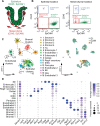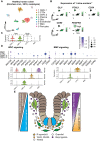Distinct populations of crypt-associated fibroblasts act as signaling hubs to control colon homeostasis
- PMID: 33306673
- PMCID: PMC7758045
- DOI: 10.1371/journal.pbio.3001032
Distinct populations of crypt-associated fibroblasts act as signaling hubs to control colon homeostasis
Abstract
Despite recent progress in recognizing the importance of mesenchymal cells for the homeostasis of the intestinal system, the current picture of how these cells communicate with the associated epithelial layer remains unclear. To describe the relevant cell populations in an unbiased manner, we carried out a single-cell transcriptome analysis of the adult murine colon, producing a high-quality atlas of matched colonic epithelium and mesenchyme. We identify two crypt-associated colonic fibroblast populations that are demarcated by different strengths of platelet-derived growth factor receptor A (Pdgfra) expression. Crypt-bottom fibroblasts (CBFs), close to the intestinal stem cells, express low levels of Pdgfra and secrete canonical Wnt ligands, Wnt potentiators, and bone morphogenetic protein (Bmp) inhibitors. Crypt-top fibroblasts (CTFs) exhibit high Pdgfra levels and secrete noncanonical Wnts and Bmp ligands. While the Pdgfralow cells maintain intestinal stem cell proliferation, the Pdgfrahigh cells induce differentiation of the epithelial cells. Our findings enhance our understanding of the crosstalk between various colonic epithelial cells and their associated mesenchymal signaling hubs along the crypt axis-placing differential Pdgfra expression levels in the spotlight of intestinal fibroblast identity.
Conflict of interest statement
The authors have declared that no competing interests exist.
Figures




References
Publication types
MeSH terms
Substances
LinkOut - more resources
Full Text Sources
Molecular Biology Databases
Miscellaneous

